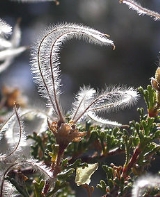
Fallugia
Encyclopedia
Fallugia is a monotypic genus of shrub
containing the single species Fallugia paradoxa, which is known by the common names Apache plume and ponil. This plant is native to the southwestern United States and northern Mexico, where it is found in arid habitats such as desert woodlands and scrub
.
The flower of the shrub is roselike when new, with rounded white petals and a center filled with many thready stamen
s and pistils
. The ovary of the flower remains after the white petals fall away, leaving many plumelike lavender styles, each 3 to 5 centimeters long. The plant may be covered with these dark pinkish clusters of curling, feathery styles after flowering. Each style is attached to a developing fruit, which is a small achene
. The fruit is dispersed when the wind catches the styles and blows them away.
Shrub
A shrub or bush is distinguished from a tree by its multiple stems and shorter height, usually under 5–6 m tall. A large number of plants may become either shrubs or trees, depending on the growing conditions they experience...
containing the single species Fallugia paradoxa, which is known by the common names Apache plume and ponil. This plant is native to the southwestern United States and northern Mexico, where it is found in arid habitats such as desert woodlands and scrub
Deserts and xeric shrublands
Deserts and xeric shrublands is a biome characterized by, relating to, or requiring only a small amount of moisture.-Definition and occurrence:...
.
Description
Fallugia paradoxa, the Apache plume, is an erect shrub not exceeding two meters in height. It has light gray or whitish peeling bark on its many thin branches. The leaves are each about a centimeter long and deeply lobed with the edges rolled under. The upper surface of the leaf is green and hairy and the underside is duller in color and scaly.The flower of the shrub is roselike when new, with rounded white petals and a center filled with many thready stamen
Stamen
The stamen is the pollen producing reproductive organ of a flower...
s and pistils
Gynoecium
Gynoecium is most commonly used as a collective term for all carpels in a flower. A carpel is the ovule and seed producing reproductive organ in flowering plants. Carpels are derived from ovule-bearing leaves which evolved to form a closed structure containing the ovules...
. The ovary of the flower remains after the white petals fall away, leaving many plumelike lavender styles, each 3 to 5 centimeters long. The plant may be covered with these dark pinkish clusters of curling, feathery styles after flowering. Each style is attached to a developing fruit, which is a small achene
Achene
An achene is a type of simple dry fruit produced by many species of flowering plants. Achenes are monocarpellate and indehiscent...
. The fruit is dispersed when the wind catches the styles and blows them away.

